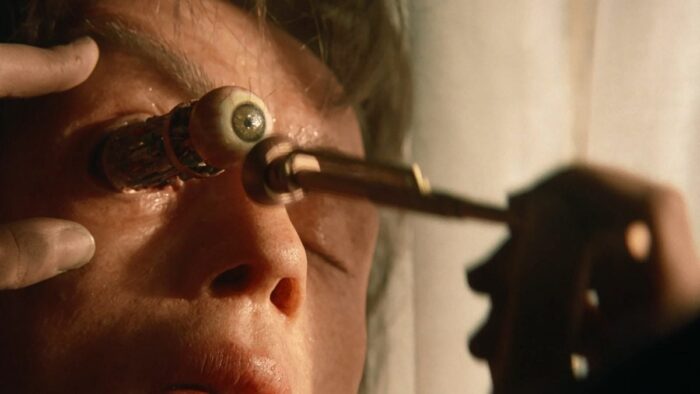By all rights, Alber Pyun’s Nemesis (1992) should be a staple midnight movie, slated alongside the likes of Eraserhead, Mad Max, and Faster Pussycat, Kill Kill! At that rate, his Jean Claude Van Damme starring Cyborg (1989) is also inexcusably absent from that tradition of raucous late-night cinema.
A veritable benchmark of neo-noir cyberpunk Nemesis has all the great good-bad bad-goodness that one craves of a midnight movie, looking and sounding like it could thrive in the breadth and the booming resonance of a theater. Alas, it nearly faded into complete obscurity outside of its star’s native Germany… until Rewind rescued it in 2019.
Thanks to PA-based indie label MVD Rewind efforts, we have Pyun’s arguable masterpiece a keystroke away, shimmering in a new HD transfer, replete with three different film edits. Although audiences have neglected it for nearly 30 years, this cult classic became one of the most anticipated titles from Rewind.
It even topped the sci-fi new releases chart on Amazon with a wave of preorders. In short, the fans came out of the woodwork for this nostalgia bomb, as did the lot of us who had never seen it but wanted to join the cult anyway. When you see the poster, it’s easy to understand why.
Man or Machine
Alex Rain, a cybernetically enhanced cop in 2027 Los Angelos, is ordered by his police commissioner Farnsworth (Tim Thomerson) to apprehend his former partner (and lover) Jared (Marjorie Monaghan) in remote Shang Liu.
Herself an android, Jared stands accused of information terrorism, passing data to an anti-cyborg organization called the Red Army Hammerheads, who are plotting to assassinate government officials embroiled in a sinister takeover conspiracy.
Suffering calamity upon calamity, Alex endures a gradual transformation as more and more of his wounded body is replaced with bionic parts-. Left to a marginal existence after a major altercation on a deep undercover mission, Farnsworth forces Alex back into uniform for a “final” mission.

The cybernetic bomb implanted in his chest during his most recent reconstruction makes “no” a slightly fatal expression. Thus Alex becomes a human powder keg used as bait to lure Jared out of hiding.
This process of becoming “Robocop in slow motion” one surgery after another is Nemesis’ underlying existential question: At what point is someone a cyborg? “86.5% is still human,” they say. Pyun shallowly ponders this question but does so with such a cool and brooding sense of mood, atmosphere, and texture that Nemesis isn’t worse for the wear for being short on intellect.
The Look of Cool
The effort and resourcefulness that went into this high-concept action thriller is evident all the way through. Made the same year as the universally celebrated but astronomically budgeted Terminator 2: Judgement Day, Nemesis enjoys none of that watershed sci-fi moment despite sharing the same Visual Effects Director (Gene Warren).
MVD Rewind makes a compelling case for Nemesis, insisting it deserves a reevaluation for what it does excellently and not so excellently. Why? Its brilliance and stupidity all issue from the same wellspring of DIY sincerity, sometimes indistinguishable from one another because both its successes and failures.
George Mooradian’s wide-angle steadicam work makes for a sleek presentation. Some truly inventive shots vitalize the larger action sequences and maximize the “passibility” of specific practical effects that benefit from the perfect framing.
For whatever Nemesis may lack in pacing or overall coherence, it boasts strong visual ideas, audacious stunts and pyrotechnics, sleek cinematography, and artful use of color filters that maximize atmosphere and compensate for a modest budget and.

The result is a cache of truly inventive shots, memorable sequences and set pieces, impressionable moods, and venerable practical effects.
With no shortage of hammy dialogue and borderline nonsensical plot developments, it is also a highly quotable treasure trove that is all the more fun to laugh with than it is to laugh at. In all honesty, its roughness around the edges makes it so easy to enjoy Nemesis for everything it does, tries to do, all that it borrows from, and all that it aims to be.
Weight of a World
The world-building accomplished in Nemesis would be expanded to ever-diminishing returns across 3 Pyun-directed sequels; Nemesis 2: Nebula, Nemesis 3: Time Lapse, and Nemesis 4: Death Angel. There is a fifth installment, Nemesis 5: The New Model (2017), which Pyun produced and is also available from MVD, which draws on all the franchise references to create a coherent final note.
While these entries ostensibly decline in overall quality and scope, they are peppered with abundant visual and structural experiments that scream potential and can be enjoyed as such, visual experiments.

Deep down, what we wanted to see was Alex Rain and his magic-pixie-dreamgirl sidekick Max Impact (Merle Kennedy) take down the simmering cyborg plot against humanity. Still, alas, we take a hard left that could either be commended or condemned. However, the sequels, which started 73 years after the first film (the year 2100), are centered on a genetically enhanced young woman named Alex (played by bodybuilder Sue Price), a lab-born experiment in the effort to destroy the reigning robot power structure.
She is sent back in time as an infant to war-torn West Africa in the ’80s (where most of Nemesis 2 and 3 take place), hunted by an unstoppable assassin and a familiar face. Her journey of self-discovery is not without its moments of intrigue or triumph, but the sheer tonal deviation from the original leaves one in the lurch, yearning for that look and feel of neo-noir cool.
The New Gold Standard
Nemesis is easily MVD Rewind’s gold standard edition, matched only by their recent 4K rehabilitation of another 1992 sci-fi relic. The Predator-via-Se7en neo-noir thriller Split Second starring Rutger Hauer.
Neither of these 90’s gems had received a genuinely respectable release in North America until MVD Rewind, so kudos are in order for the underdog label. This shouldn’t be mistaken for charity, though. It was simply the right thing to do.
